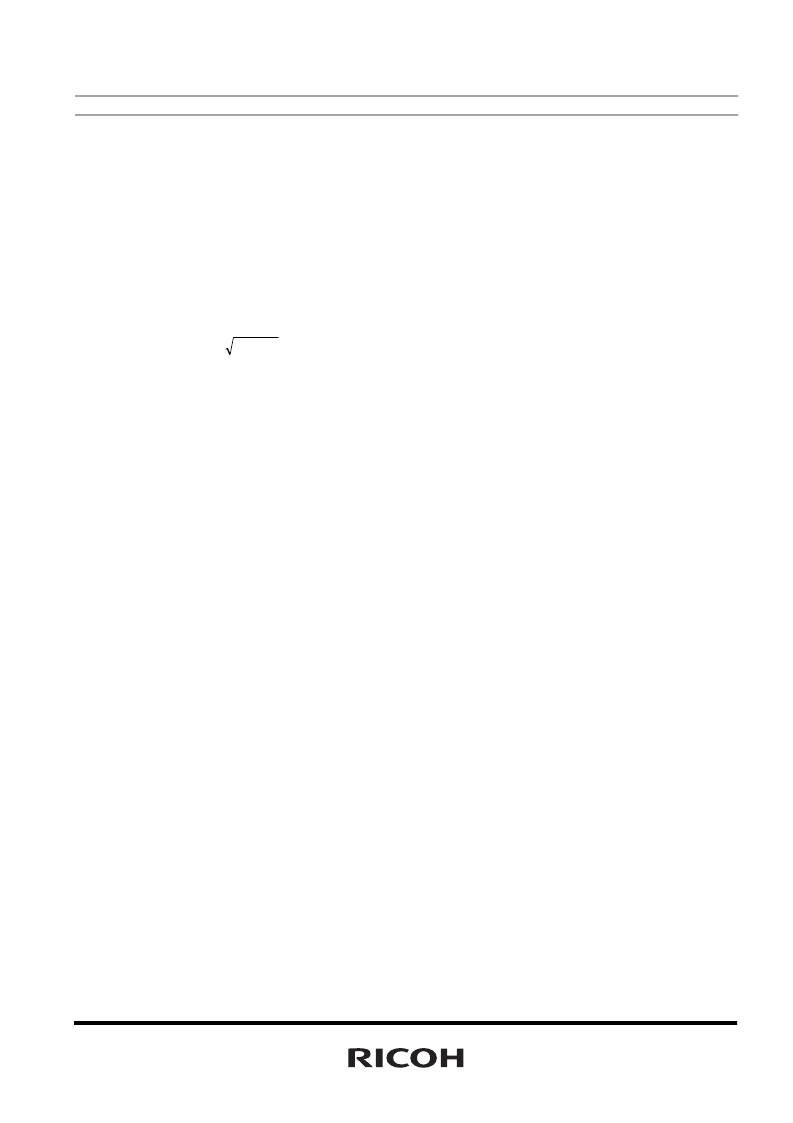- 您現(xiàn)在的位置:買賣IC網(wǎng) > PDF目錄384863 > R1212D101A (Ricoh Co., Ltd.) STEP-UP DC/DC CONTOLLER PDF資料下載
參數(shù)資料
| 型號: | R1212D101A |
| 廠商: | Ricoh Co., Ltd. |
| 英文描述: | STEP-UP DC/DC CONTOLLER |
| 中文描述: | 升壓型DC /直流位指示 |
| 文件頁數(shù): | 11/41頁 |
| 文件大小: | 690K |
| 代理商: | R1212D101A |
第1頁第2頁第3頁第4頁第5頁第6頁第7頁第8頁第9頁第10頁當前第11頁第12頁第13頁第14頁第15頁第16頁第17頁第18頁第19頁第20頁第21頁第22頁第23頁第24頁第25頁第26頁第27頁第28頁第29頁第30頁第31頁第32頁第33頁第34頁第35頁第36頁第37頁第38頁第39頁第40頁第41頁

R1212D
Output Voltage Setting Method and Phase Compensation Making Method
The feedback voltage is controlled into 1.0V. The output voltage can be set with divider resistors for voltage
setting, R1 and R2 as shown in typical application of the previous page. Refer to the next formula.
Output Voltage
=
V
FB
×
(R1
+
R2)/R2
Output Voltage is adjustable with setting various resistor values combination.
R1
+
R2 should be equal or less than 500k
As for the DC/DC converter, depending on the load current and external components such as L and C, phase
may loss around 180°. In such case, phase margin becomes less and may be unstable. To avoid this situation,
make the phase margin more. The pole is made with external components L and C.
)
3
C
L
×
}
C4, C5, R3, and R4 shown in the diagram are for making phase compensation. The gain of the system can be
set with using these resistors and capacitors. Each value in the diagram is just an example.
R4 and C5 make zero (the backward phase).
Fzero
~
1/(2
×π×
R4
×
C5)
Choose the R4 and C5 value so as to make the cutoff frequency of this zero point close to the cutoff frequency of
the pole by external components, L and C.
For example, supposed that L
=
10
μ
H and C
OUT
(C3)
=
10
μ
F, the cutoff frequency of the pole is approximately
16kHz. Therefore make the cutoff frequency of the zero point close to 16kHz. Then R4
=
4.7k
and C5
=
1000pF
are appropriate values.
As for setting the gain, the ratio of the composite resistor (RT: RT
=
R1
×
R2/(R1
+
R2)) to R4 is the key.
If the R4 against the composite resistor, R
T,
is large, the gain becomes also large. If the gain is large, the
response characteristic is improved, however, too large gain makes the system be unstable.
If the spike noise of V
OUT
may be large, the spike noise may be picked into V
FB
pin, and the unstable operation
may result. In this case, a resistor R3, shown in typical application of the previous page. The recommended
resistance value of R3 is in the range from 1k
to 5k
. Then, noise level will be decreased.
Further, R1 and C4 makes another zero point (the backward phase).
Fzero
~
1/(2
×π×
R1
×
C4)
Make the cutoff frequency of this zero point be lower than the cutoff frequency of the pole by external
components, or, L and C. Herein, R1
=
180k
and C4
=
1000pF are appropriate values.
Select the Power MOSFET, the diode, capacitors and the inductor within ratings (Voltage, Current, Power) of
this IC. Choose the power MOSFET with low threshold voltage depending on the input voltage to be able to
turn on the FET completely. Choose the diode with low V
F
such as Shottky type with low reverse current I
R
,
and with fast switching speed. When an external transistor is switching, spike voltage may be generated
caused by an inductor, therefore recommended voltage tolerance of capacitor connected to V
OUT
is twice as
much as the setting voltage or more.
The soft-start time and the maximum duty cycle setting method
The soft-start time and the maximum duty cycle can be set with R5, R6, and C7 values connected to the
V
REFOUT
pin and the DTC pin. (Refer to the timing chart: Soft-start operation.)
11
Fpole
~
1/{2
×π×
(
相關(guān)PDF資料 |
PDF描述 |
|---|---|
| R1212D101C | STEP-UP DC/DC CONTOLLER |
| R1212D102A | STEP-UP DC/DC CONTOLLER |
| R1212D102C | STEP-UP DC/DC CONTOLLER |
| R1224N | PWM/VFM step-down DC/DC Converter |
| R1224N102G | PWM/VFM step-down DC/DC Converter |
相關(guān)代理商/技術(shù)參數(shù) |
參數(shù)描述 |
|---|---|
| R1212D101C | 制造商:RICOH 制造商全稱:RICOH electronics devices division 功能描述:STEP-UP DC/DC CONTOLLER |
| R1212D102A | 制造商:RICOH 制造商全稱:RICOH electronics devices division 功能描述:STEP-UP DC/DC CONTOLLER |
| R1212D102C | 制造商:RICOH 制造商全稱:RICOH electronics devices division 功能描述:STEP-UP DC/DC CONTOLLER |
| R121315000 | 制造商:Radiall 功能描述:BULKHEAD JACK SOLDER TYPE CABLE - Bulk |
| R121315009 | 功能描述:RF 連接器 PR DR ECR SOUD CABLE .085 RoHS:否 制造商:Bomar Interconnect 產(chǎn)品:Connectors 射頻系列:BNC 型式:Jack (Female) 極性: 觸點電鍍:Gold 阻抗: 端接類型:Solder 主體類型:Straight Bulkhead 電纜類型: |
發(fā)布緊急采購,3分鐘左右您將得到回復。